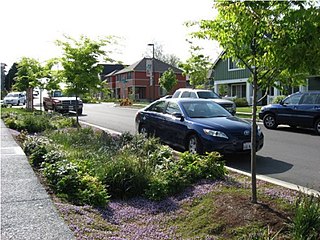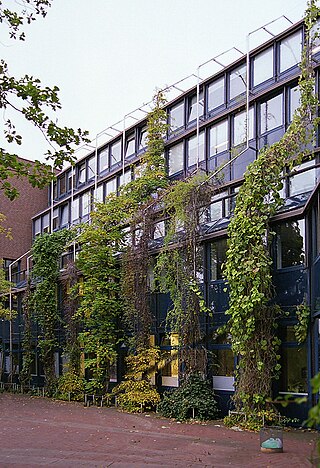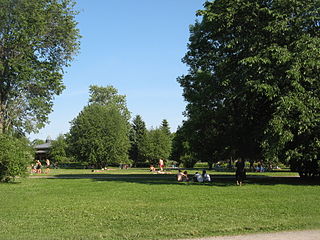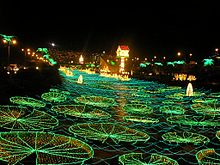
Urban areas usually experience the urban heat island (UHI) effect, that is, they are significantly warmer than surrounding rural areas. The temperature difference is usually larger at night than during the day, and is most apparent when winds are weak, under block conditions, noticeably during the summer and winter. The main cause of the UHI effect is from the modification of land surfaces while waste heat generated by energy usage is a secondary contributor. A study has shown that heat islands can be affected by proximity to different types of land cover, so that proximity to barren land causes urban land to become hotter and proximity to vegetation makes it cooler. As a population center grows, it tends to expand its area and increase its average temperature. The term heat island is also used; the term can be used to refer to any area that is relatively hotter than the surrounding, but generally refers to human-disturbed areas.

The term built environment refers to human-made conditions and is often used in architecture, landscape architecture, urban planning, public health, sociology, and anthropology, among others. These curated spaces provide the setting for human activity and were created to fulfill human desires and needs. The term can refer to a plethora of components including the traditionally associated buildings, cities, public infrastructure, transportation, open space, as well as more conceptual components like farmlands, dammed rivers, wildlife management, and even domesticated animals.

Urban ecology is the scientific study of the relation of living organisms with each other and their surroundings in an urban environment. An urban environment refers to environments dominated by high-density residential and commercial buildings, paved surfaces, and other urban-related factors that create a unique landscape. The goal of urban ecology is to achieve a balance between human culture and the natural environment.

Environmental health is the branch of public health concerned with all aspects of the natural and built environment affecting human health. In order to effectively control factors that may affect health, the requirements that must be met in order to create a healthy environment must be determined. The major sub-disciplines of environmental health are environmental science, toxicology, environmental epidemiology, and environmental and occupational medicine.

A polycyclic aromatic hydrocarbon (PAH) is a class of organic compounds that is composed of multiple aromatic rings. The simplest representative is naphthalene, having two aromatic rings, and the three-ring compounds anthracene and phenanthrene. PAHs are uncharged, non-polar and planar. Many are colorless. Many of them are found in coal and in oil deposits, and are also produced by the incomplete combustion of organic matter—for example, in engines and incinerators or when biomass burns in forest fires.

Physical activity is defined as any voluntary bodily movement produced by skeletal muscles that requires energy expenditure. Physical activity encompasses all activities, at any intensity, performed during any time of day or night. It includes both exercise and incidental activity integrated into daily routine. This integrated activity may not be planned, structured, repetitive or purposeful for the improvement of fitness, and may include activities such as walking to the local shop, cleaning, working, active transport etc. Lack of physical activity is associated with a range of negative health outcomes, whereas increased physical activity can improve physical and mental health, as well as cognitive and cardiovascular health. There are at least eight investments that work to increase population-level physical activity, including whole-of-school programmes, active transport, active urban design, healthcare, public education and mass media, sport for all, workplaces and community-wide programmes. Physical activity increases energy expenditure and is a key regulator in controlling body weight.
Tranquillity is the quality or state of being tranquil; that is, calm, serene, and worry-free. The word tranquillity appears in numerous texts ranging from the religious writings of Buddhism—where the term passaddhi refers to tranquillity of the body, thoughts, and consciousness on the path to enlightenment—to an assortment of policy and planning guidance documents, where interpretation of the word is typically linked to engagement with the natural environment. It is also famously used in the Preamble to the United States Constitution, which describes one of the purposes for which the document was establishing the government as to "insure domestic Tranquility".

In ecology, urban ecosystems are considered a ecosystem functional group within the intensive land-use biome. They are structurally complex ecosystems with highly heterogeneous and dynamic spatial structure that is created and maintained by humans. They include cities, smaller settlements and industrial areas, that are made up of diverse patch types. Urban ecosystems rely on large subsidies of imported water, nutrients, food and other resources. Compared to other natural and artificial ecosystems human population density is high, and their interaction with the different patch types produces emergent properties and complex feedbacks among ecosystem components.

Green infrastructure or blue-green infrastructure refers to a network that provides the “ingredients” for solving urban and climatic challenges by building with nature. The main components of this approach include stormwater management, climate adaptation, the reduction of heat stress, increasing biodiversity, food production, better air quality, sustainable energy production, clean water, and healthy soils, as well as more anthropocentric functions, such as increased quality of life through recreation and the provision of shade and shelter in and around towns and cities. Green infrastructure also serves to provide an ecological framework for social, economic, and environmental health of the surroundings. More recently scholars and activists have also called for green infrastructure that promotes social inclusion and equality rather than reinforcing pre-existing structures of unequal access to nature-based services.

Air pollution is the contamination of air due to the presence of substances in the atmosphere that are harmful to the health of humans and other living beings, or cause damage to the climate or to materials. It is also the contamination of indoor or outdoor surrounding either by chemical activities, physical or biological agents that alters the natural features of the atmosphere. There are many different types of air pollutants, such as gases, particulates, and biological molecules. Air pollution can cause diseases, allergies, and even death to humans; it can also cause harm to other living organisms such as animals and crops, and may damage the natural environment or built environment. Air pollution can be caused by both human activities and natural phenomena.

Greening is the process of transforming living environments, and also artifacts such as a space, a lifestyle or a brand image, into a more environmentally friendly version. The act of greening generally involves incorporating more environmentally friendly systems into one's environment, such as the home, work place, and general lifestyle.
Disinfection by-products (DBPs) are organic and inorganic compounds resulting from chemical reactions between organic and inorganic substances such as contaminates and chemical treatment disinfection agents, respectively, in water during water disinfection processes.

In land-use planning, urban green space is open-space areas reserved for parks and other "green spaces", including plant life, water features - also referred to as blue spaces - and other kinds of natural environment. Most urban open spaces are green spaces, but occasionally include other kinds of open areas. The landscape of urban open spaces can range from playing fields to highly maintained environments to relatively natural landscapes.

Active mobility, soft mobility, active travel, active transport or active transportation is the transport of people or goods, through non-motorized means, based around human physical activity. The best-known forms of active mobility are walking and cycling, though other modes include running, rowing, skateboarding, kick scooters and roller skates. Due to its prevalence, cycling is sometimes considered separately from the other forms of active mobility.
In epidemiology, environmental diseases are diseases that can be directly attributed to environmental factors. Apart from the true monogenic genetic disorders, which are rare, environment is a major determinant of the development of disease. Diet, exposure to toxins, pathogens, radiation, and chemicals found in almost all personal care products and household cleaners, stress, racism, and physical and mental abuse are causes of a large segment of non-hereditary disease. If a disease process is concluded to be the result of a combination of genetic and environmental factor influences, its etiological origin can be referred to as having a multifactorial pattern.

The effects of climate change on human health are increasingly well studied and quantified. Rising temperatures and changes in weather patterns are increasing the frequency and severity of heat waves, wildfires, droughts, floods, landslides, hurricanes, and other causes of injury and illness. Heat waves and extreme weather events have a big impact on health both directly and indirectly. Direct effects of exposure to high and extended temperatures include illness, reduced labour capacity for outdoor workers, and heat-related mortality.

The effects of climate change on mental health and wellbeing are documented. This is especially the case for vulnerable populations and those with pre-existing serious mental illness. There are three broad pathways by which these effects can take place: directly, indirectly or via awareness. The direct pathway includes stress-related conditions caused by exposure to extreme weather events. These include post-traumatic stress disorder (PTSD). Scientific studies have linked mental health to several climate-related exposures. These include heat, humidity, rainfall, drought, wildfires and floods. The indirect pathway can be disruption to economic and social activities. An example is when an area of farmland is less able to produce food. The third pathway can be of mere awareness of the climate change threat, even by individuals who are not otherwise affected by it.
Nature therapy, sometimes referred to as ecotherapy, forest therapy, forest bathing, grounding, earthing, Shinrin-Yoku or Sami Lok, is a practice that describes a broad group of techniques or treatments using nature to improve mental or physical health.
Healthy building refers to an emerging area of interest that supports the physical, psychological, and social health and well-being of people in buildings and the built environment. Buildings can be key promoters of health and well-being since most people spend a majority of their time indoors. According to the National Human Activity Pattern Survey, Americans spend "an average of 87% of their time in enclosed buildings and about 6% of their time in enclosed vehicles."

Nature exposure and mental health refers to the association between an individual interacting with natural environments and its effect on the individual's mental health. Most studies consider any interaction with nature as exposure, such as a hike, being in a forest or a place with water, going on a walk in a park, etc. Currently there is extensive research on the impact of the exposure to nature on people, which finds a beneficial association in various ways. Studies show that the contact of human beings with nature has decreased with the contemporary lifestyle of being most of the time indoors and with increasing time spent on screens. However, the interaction with nature has been considered to be a general health promoter thanks to the many benefits it brings to mental health and cognition as well. As a consequence, therapists use nature in their treatments to improve mental or physical health. These treatments and techniques are called ecotherapy.





















